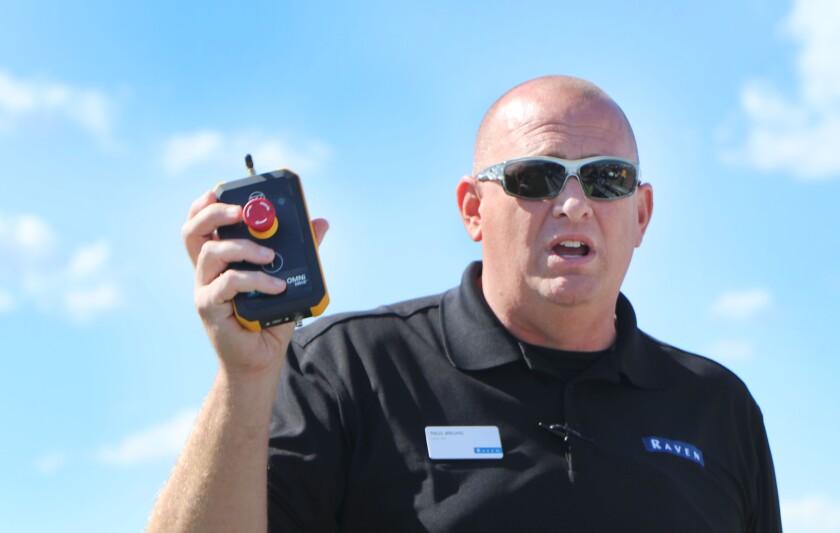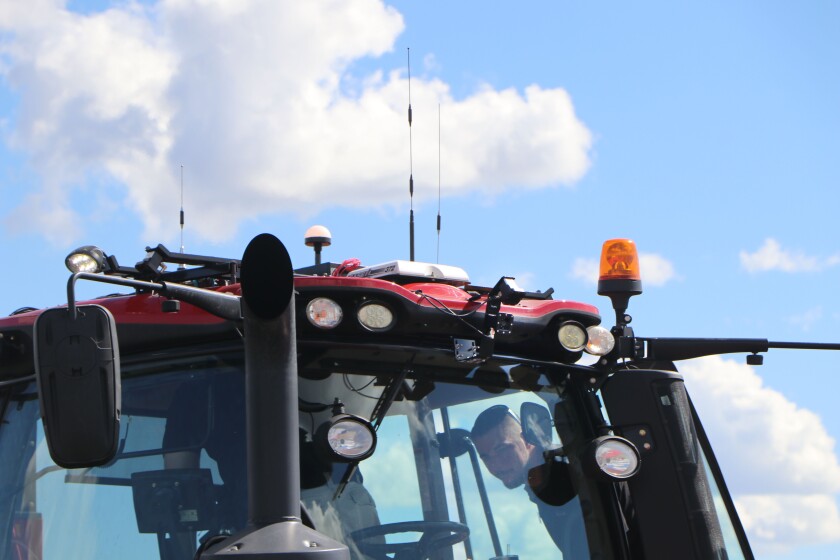WEST FARGO, North Dakota — At the Big Iron farm show this year you could actually drive an unmanned tractor running across a field pulling, pulling a grain cart to unload a combine on-the-go.
Raven Industries Inc., of Sioux Falls, South Dakota, and Titan Machinery Inc., of Fargo, a multi-store dealer of CNH equipment — fielded the OMNiDRIVEM “autonomous grain cart” setup in the show’s trademark field days at Red River Valley Fairgrounds in West Fargo.
Big Iron opened Sept. 14, 2021, and ran through Sept. 16.

ADVERTISEMENT
Paul Bruns, a Raven autonomy product sales specialist, was describing the system in demonstrations from 1 p.m. to 3 p.m., daily, just south of the grandstand. Despite history being made for the event, only a handful of farmers attended the first-day demonstration.
Jim Lilleberg, director of precision ag and machine control for Titan Machinery Inc., said his company had been a long-time Raven dealer.
“A lot of our customers have trouble getting labor — have trouble getting help — especially at that harvest time," he said. "This is going to really help those people who have problems getting help.”
Farmer Phil Faught, 39, attended the event with father, Mike, 68. They grow wheat, soybeans and corn at Abasaraka, North Dakota.
“It’s really weird to see a tractor without an operator, but just finding labor to do those kind of jobs is becoming harder and harder. It seems like this would be a suitable way to work by yourself in the field,” he said, adding, “I can see this being on most fields — 10 years, for sure.”

ADVERTISEMENT
Coming soon
Bruns described its OMNiDRIVE system as simple to operate.
“If you can run Google Maps or Apple Maps to set a ‘pushpin’ on how to get to Sioux Falls, South Dakota, you can run this thing,” Bruns said.
Raven has 14 dealers across the country, including retailers, including Titan, which this year was offering the product in a half-dozen of its stores, and independent precision ag dealers.

Raven has already sold OMNiDRIVE systems to 16 farmers in the Dakotas and Minnesota for delivery and installation after Nov. 1, 2021.
It costs “under $50,000” for hardware, data plan, plus $3,000 per year subscription fee. The subscription covers software updates “over the air.” The system is built to be a “foundation to move onto other applications in the future, like tillage.” The cost is partly dependent on whether the farmer already has RTK on both the tractor and the combine.
"We’ve run the system with sugar beet harvesters, 'pickle' (cucumber) harvesters,” Bruns said.
ADVERTISEMENT

Clean installation
Bruns said it takes a day to install the system on the cart tractor, and another three or four hours on the combine, plus calibration, validation and set-up.
The system employs a ruggedized, dedicated Windows 10 tablet computer in the combine/harvester.
Step one for operation is to establish a field boundary, either from a “shape file” pulled from Climate, SMS, or any other mapping software, or hand-drawn. Second, the operator must identify what part of the field is harvested, so the tractor can’t go there. Obstacles or features that won’t change are loaded ahead of time.
In the field, harvest operator first parks next to the autonomous machine and sets it to sync.
While harvesting, he calls the OMNiDRIVE when his combine hopper is three-quarters full. He drops a "cross-hair" on the computer screen, indicating where he thinks he’ll intersect with the cart. The tractor immediately heads for that point at up to 15 mph. It then slows to 4 mph until it automatically syncs, matching speed and position, for on-the-go loading. When needed, the combine operator taps the screen to “nudge” the machine 3 feet forward or back, 1 foot out or in. (Company engineers can customize these specs.)
ADVERTISEMENT
When the cart is full, the combine operator hits a “stop” button. This sends the cart to an unload point where the trucks are waiting, or a “stage point.” The operator sets midpoints if he doesn’t want a straight path.
"On the fly, the machine will develop its own path plan, based on what’s already been harvested or if there’s any obstacles in the field — a wet spot, or a rock pile, or REA pole,” Bruns said. “It ‘knows’ those obstacles are there. It will plan its path around them, and will also plan its path around existing crop in the field.”
Re-allocating people
Bruns said system requires a person a) to unload, b) drive down a road, and c) to open fields.
Once the system gets going, the farm can let the autonomous tractor do repetitive cart-driving while employees can be re-allocated to more “mentally challenging” tasks that can’t be automated.
“What’s it worth to get something else done on the farm that person in the cab could be doing?” Bruns asked the show-goers. “What’s the value of getting all your fall fertilizer in on time? Your ditching done in the fall.”

He said the return-on-investment comes from pulling the cart driver — at least three-fourths of the time — and moving them into another semi, another truck, or starting a different operation.
ADVERTISEMENT
“We do not unload autonomously into the truck, just because of the dynamics of truck size, is the trap closed, is the tarp open, all those crucial things, ” Bruns emphasized. “We do not autonomously back the tractor up. We sync and only run autonomously in a forward motion.”
Bruns said some farmers think it’s only for “big farmers,” but in fact it’s producers from 1,000 to 4,000 acres who seem the most excited.
“It’s hard to justify one more full-time person on the farm, especially on a part-time basis, during the harvest season,” he said.
Absolute ‘journey’
Developing the system is an “absolute journey,” Bruns said, and expects it to change over time.
For example, it’s starting as a “one-to-one” relationship — one combine, one autonomous tractor/cart. The company is working “feverishly” to add multiple harvesters to one cart.
They also need “multiple machine control,” meaning multiple combines for one cart or multiple carts to one combine.
“As you bring together multiple machines, stitching all of that data together is a challenge,” he said. “Being able to do it very, very quickly and efficiently takes a lot of bandwidth from a communications standpoint. There’s a lot of dynamics behind that.”
Raven is working to expand platforms — tractors that are compatible. They are only on a front wheel-assist system and need an “articulated solution, very, very soon,” meaning four-wheel drives and larger carts used in larger producers.
ADVERTISEMENT
There is a mountain of “functionality “requests” from farmers. One example is remote engine start-stop, to save on fuel and engine hours when the machine is idle.

CNH acquisition
Raven has been in Sioux Falls since the 1950s. It started out as a flow and application company, but has diversified into engineered films as well as Aerostar products, involving radar and technology used on ships.
In 2016, Raven started developing its OMNiDRIVE concept at Ames, Iowa. They started testing in 2017 and in 2018 put it on a dozen systems across the U.S. and southern Canada. In 2019 they added 14 systems demonstrating and capturing feedback on how the system needs to be. In 2020, they cut back testing due to COVID complications.
In March 2020, Raven purchased DOT Technology Corp., of Regina, Saskatchewan, Canada. DOT had a driverless product Smart Ag product that Raven later rebranded as OMNiPOWER. (That product was not shown at Big Iron.) DOT’s autonomous power unit, which picks up its implements such as a sprayer or a fertilizer spreader.
In February 2021, Raven sold their first OMNiDRIVE system to a Nebraska farmer.
They demonstrated the system at earlier ag shows and field days in Illinois, Nebraska and South Dakota. Bruns said the company’s “limited release,” to make sure the manufacturers and dealers are up to speed.
“We have to walk before we can run,” Bruns said. He likened the adoption rate to be similar to “auto steer” systems that were new more than 25 years ago.
Raven has commitments for more than 80 OMNiDRIVEsystems for this fall, and will have 35 systems running this fall, including more than a dozen in the Dakotas and Minnesota, Bruns said. (Separately, John Deere has a product called MachineSync, which requires someone to be in the tractor cab to bring the tractor into a “safe box” or zone, next to a harvester.)
Significantly, on June 21, 2021, CNH Industrial N.V., based in the Netherlands, announced it would acquire Raven Industries. The $2.1 billion deal is expected to close in December 2021. Bruns said Raven will become a division of CNHI, and so far will keep its name and brand.
Prior to the CNH deal, Raven sold its product through its own dealer network, which included some CNH dealers. Titan Machinery of West Fargo, which has over 70 stores in the U.S. and Europe. Moving ahead, CNH has said it wants to continue it’s non-CNH marketing through AGCO partners, as well as independents.
Raven’s ‘autonomous’ cart, at a glance
Tractor specs. The system currently is limited to front-wheel-assist tractors — John Deere 8R wheel machines dating to about 2010, and CNH Magnum CBT transmission dating back to 2012. The system requires a “calibratable,” or adjustable turning radius. The company is planning for later release of products that run larger, “articulated,” or four-wheel-drive tractors.
RTK/cell service. The system uses cellular communication to start a field, RTK (real-time kinematic global positioning) for steering and navigation, When those are unavailable the operator can set up a portable base. (Cellular-based RTK is fine — MyWay, DigiFarm are acceptable. But SF3 and Trimble RTX and TerraStar X are not compatible.) The system uses about 6 gigabytes of data during months of use, but service can throttle back to about $5 a month when not in use. Within a field, the combine and cart tractor communicate through an instantaneous, shortwave radio signal, similar to RTK, and does not rely on cellular control.
Human needs. The system is designed for a human to drive it down the road and to handle unloading. A human has to be in the cab when the harvester is “opening” the field, or “breaking out new lands” across a field. “We’ve actually recommended that if you’re going to put three lands in a field, that you do that right away,” Bruns said. “Then you can remove somebody from the cab and let the system function autonomously after that — successfully.” With the flip of a switch, the tractor goes back to manual operation.
Safety, cameras/sensors. In front of its “suitcase weights,” the tractor has a radar sensor, checking for obstacles that are 150 feet in front of the tractor. The tractor cab has four “hazard cameras,” pointing down. A “perception camera” is trained with hundreds of thousands of images to distinguish among trucks, combines, people. The system allows for multiple “lock-out, tag-out” switch boxes for people to stop the tractor, in a line-of-sight, up to a half-mile away. An alarm horn indicates when the tractor will move. Bruns said he would make sure the combine has “autosteer.”





